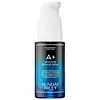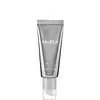What's inside
What's inside
 Key Ingredients
Key Ingredients

 Benefits
Benefits

 Concerns
Concerns

 Ingredients Side-by-side
Ingredients Side-by-side

Water
Skin ConditioningPropanediol
SolventDimethyl Isosorbide
SolventTriheptanoin
Skin ConditioningDimethicone
EmollientGlycerin
HumectantPentylene Glycol
Skin ConditioningHexyldecanol
EmollientDisiloxane
Skin ConditioningCetyl PEG/PPG-10/1 Dimethicone
EmulsifyingDiheptyl Succinate
EmollientPropylene Carbonate
SolventHydroxypinacolone Retinoate
Skin ConditioningPPG-24-Glycereth-24
EmulsifyingPhenyl Trimethicone
Skin ConditioningRetinol
Skin ConditioningUbiquinone
AntioxidantHoney Extract
HumectantSodium Hyaluronate Crosspolymer
HumectantAlgae Extract
EmollientZingiber Officinale Extract
Skin ConditioningOpuntia Ficus-Indica Fruit Extract
Skin ConditioningBisabolol
MaskingButyrospermum Parkii Butter
Skin ConditioningPhospholipids
Skin ConditioningSaccharomyces Cerevisiae Extract
Skin ConditioningLecithin
EmollientSodium Acrylates Copolymer
Hydrogenated Polyisobutene
Emollient1,2-Hexanediol
Skin Conditioning4-T-Butylcyclohexanol
MaskingPolyglyceryl-10 Stearate
Skin ConditioningCaprylyl Glycol
EmollientHelianthus Annuus Seed Oil
EmollientSorbitol
HumectantCetylhydroxyproline Palmitamide
Skin ConditioningPolysilicone-11
Benzoic Acid
MaskingDehydroacetic Acid
PreservativeSodium Phytate
Glyceryl Polyacrylate
Polysorbate 80
EmulsifyingHydroxyphenyl Propamidobenzoic Acid
Skin ConditioningStearic Acid
CleansingBrassica Campestris Sterols
EmollientPvp
Emulsion StabilisingCapryloyl Glycerin/Sebacic Acid Copolymer
Skin ConditioningSodium Benzoate
MaskingAlcohol
AntimicrobialPotassium Phosphate
BufferingDecyl Glucoside
CleansingPhenoxyethanol
PreservativeHexylene Glycol
EmulsifyingPotassium Sorbate
PreservativeTocopherol
AntioxidantWater, Propanediol, Dimethyl Isosorbide, Triheptanoin, Dimethicone, Glycerin, Pentylene Glycol, Hexyldecanol, Disiloxane, Cetyl PEG/PPG-10/1 Dimethicone, Diheptyl Succinate, Propylene Carbonate, Hydroxypinacolone Retinoate, PPG-24-Glycereth-24, Phenyl Trimethicone, Retinol, Ubiquinone, Honey Extract, Sodium Hyaluronate Crosspolymer, Algae Extract, Zingiber Officinale Extract, Opuntia Ficus-Indica Fruit Extract, Bisabolol, Butyrospermum Parkii Butter, Phospholipids, Saccharomyces Cerevisiae Extract, Lecithin, Sodium Acrylates Copolymer, Hydrogenated Polyisobutene, 1,2-Hexanediol, 4-T-Butylcyclohexanol, Polyglyceryl-10 Stearate, Caprylyl Glycol, Helianthus Annuus Seed Oil, Sorbitol, Cetylhydroxyproline Palmitamide, Polysilicone-11, Benzoic Acid, Dehydroacetic Acid, Sodium Phytate, Glyceryl Polyacrylate, Polysorbate 80, Hydroxyphenyl Propamidobenzoic Acid, Stearic Acid, Brassica Campestris Sterols, Pvp, Capryloyl Glycerin/Sebacic Acid Copolymer, Sodium Benzoate, Alcohol, Potassium Phosphate, Decyl Glucoside, Phenoxyethanol, Hexylene Glycol, Potassium Sorbate, Tocopherol
Water
Skin ConditioningCaprylic/Capric Triglyceride
MaskingGlycerin
HumectantIsododecane
EmollientCetearyl Olivate
Sodium Acrylate/Sodium Acryloyldimethyl Taurate Copolymer
Emulsion StabilisingCyclodextrin
AbsorbentCetearyl Alcohol
EmollientSorbitan Olivate
EmulsifyingTocopheryl Acetate
AntioxidantSqualane
EmollientHydroxyethyl Acrylate/Sodium Acryloyldimethyl Taurate Copolymer
Emulsion StabilisingHydroxyacetophenone
Antioxidant3-O-Ethyl Ascorbic Acid
Skin ConditioningPhenoxyethanol
PreservativeHydroxypropyl Methylcellulose
Emulsion StabilisingSodium Hyaluronate
HumectantTetrahexyldecyl Ascorbate
AntioxidantRubus Chamaemorus Seed Oil
Skin ConditioningPentylene Glycol
Skin ConditioningDaucus Carota Sativa Seed Oil
EmollientRetinal
Skin ConditioningAlumina
AbrasiveIsostearic Acid
CleansingLecithin
EmollientSodium Polyaspartate
HumectantPolyglyceryl-3 Polyricinoleate
EmulsifyingLonicera Japonica Flower Extract
Skin ConditioningLonicera Caprifolium Flower Extract
PerfumingPolyhydroxystearic Acid
EmulsifyingDisodium EDTA
Ethylhexylglycerin
Skin ConditioningStearic Acid
CleansingPolysorbate 60
EmulsifyingSorbitan Isostearate
EmulsifyingBHT
AntioxidantVanilla Planifolia Fruit Extract
Skin ConditioningDipteryx Odorata Bean Extract
MaskingCoumarin
PerfumingCI 14700
Cosmetic ColorantCI 77891
Cosmetic ColorantWater, Caprylic/Capric Triglyceride, Glycerin, Isododecane, Cetearyl Olivate, Sodium Acrylate/Sodium Acryloyldimethyl Taurate Copolymer, Cyclodextrin, Cetearyl Alcohol, Sorbitan Olivate, Tocopheryl Acetate, Squalane, Hydroxyethyl Acrylate/Sodium Acryloyldimethyl Taurate Copolymer, Hydroxyacetophenone, 3-O-Ethyl Ascorbic Acid, Phenoxyethanol, Hydroxypropyl Methylcellulose, Sodium Hyaluronate, Tetrahexyldecyl Ascorbate, Rubus Chamaemorus Seed Oil, Pentylene Glycol, Daucus Carota Sativa Seed Oil, Retinal, Alumina, Isostearic Acid, Lecithin, Sodium Polyaspartate, Polyglyceryl-3 Polyricinoleate, Lonicera Japonica Flower Extract, Lonicera Caprifolium Flower Extract, Polyhydroxystearic Acid, Disodium EDTA, Ethylhexylglycerin, Stearic Acid, Polysorbate 60, Sorbitan Isostearate, BHT, Vanilla Planifolia Fruit Extract, Dipteryx Odorata Bean Extract, Coumarin, CI 14700, CI 77891
 Reviews
Reviews

Ingredients Explained
These ingredients are found in both products.
Ingredients higher up in an ingredient list are typically present in a larger amount.
Glycerin is already naturally found in your skin. It helps moisturize and protect your skin.
A study from 2016 found glycerin to be more effective as a humectant than AHAs and hyaluronic acid.
As a humectant, it helps the skin stay hydrated by pulling moisture to your skin. The low molecular weight of glycerin allows it to pull moisture into the deeper layers of your skin.
Hydrated skin improves your skin barrier; Your skin barrier helps protect against irritants and bacteria.
Glycerin has also been found to have antimicrobial and antiviral properties. Due to these properties, glycerin is often used in wound and burn treatments.
In cosmetics, glycerin is usually derived from plants such as soybean or palm. However, it can also be sourced from animals, such as tallow or animal fat.
This ingredient is organic, colorless, odorless, and non-toxic.
Glycerin is the name for this ingredient in American English. British English uses Glycerol/Glycerine.
Learn more about GlycerinLecithin is a term for a group of substances found in the cell membranes of plants, animals, and humans. They are made up of mixture of phospholipids.
This ingredient has emollient and emulsifying properties.
As an emollient, lecithen helps soften the skin and creates a barrier to keep moisture in.
As an emulsifier, it also helps prevent water and oil ingredients from separating. Lecithin can also help ingredients be better absorbed by the skin.
This is because the phospholipids in lecithin produce liposomes. Liposomes help other ingredients get through the skin barrier.
Depending on the source of this ingredient, lecithin may not be fungal acne safe. This is because some sources of lecithin come from soybean oil, which may feed the malassezia yeast that feeds fungal acne.
We recommend reaching out to the brand you are purchasing from to inquire about the source of their lecithin.
Some other names for this ingredient include soy lecithin and deoiled soy lecithin.
Learn more about LecithinPentylene glycol is typically used within a product to thicken it. It also adds a smooth, soft, and moisturizing feel to the product. It is naturally found in plants such as sugar beets.
The hydrophilic trait of Pentylene Glycol makes it a humectant. As a humectant, Pentylene Glycol helps draw moisture from the air to your skin. This can help keep your skin hydrated.
This property also makes Pentylene Glycol a great texture enhancer. It can also help thicken or stabilize a product.
Pentylene Glycol also acts as a mild preservative and helps to keep a product microbe-free.
Some people may experience mild eye and skin irritation from Pentylene Glycol. We always recommend speaking with a professional about using this ingredient in your routine.
Pentylene Glycol has a low molecular weight and is part of the 1,2-glycol family.
Learn more about Pentylene GlycolPhenoxyethanol is a preservative that has germicide, antimicrobial, and aromatic properties. Studies show that phenoxyethanol can prevent microbial growth. By itself, it has a scent that is similar to that of a rose.
It's often used in formulations along with Caprylyl Glycol to preserve the shelf life of products.
Stearic Acid is a fatty acid. It is an emollient, emulsifier, and texture enhancer.
As an emollient, stearic acid helps soften skin. It aids the skin's protective barrier by preventing water loss. It also provides a gentle cleansing effect without stripping away natural oils.
Stearic acid may also be used to enhance the texture of products. It can add volume and stabilize ingredients such as water and oil. This can help water and oil ingredients from separating.
Sources of stearic acid include animal or vegetable fats/oils such as coconut or shea. It can be naturally found in butter, cocoa butter, shea butter, vegetable fats, and animal tallow.
This ingredient may not be Malassezia folliculitis, or fungal-acne safe.
Learn more about Stearic AcidWater. It's the most common cosmetic ingredient of all. You'll usually see it at the top of ingredient lists, meaning that it makes up the largest part of the product.
So why is it so popular? Water most often acts as a solvent - this means that it helps dissolve other ingredients into the formulation.
You'll also recognize water as that liquid we all need to stay alive. If you see this, drink a glass of water. Stay hydrated!
Learn more about Water